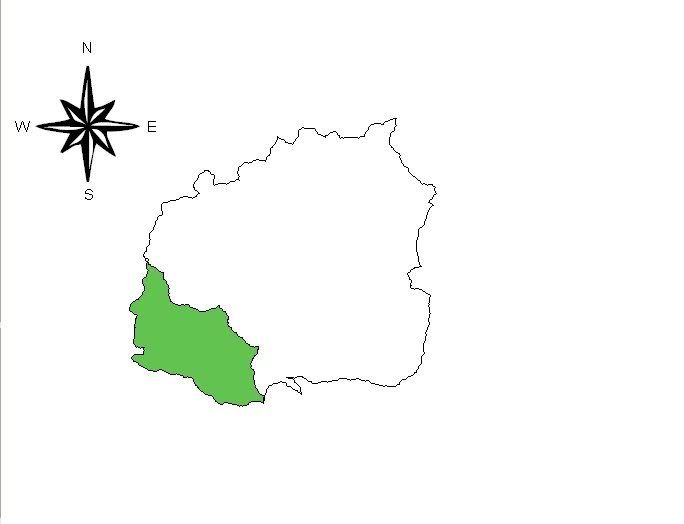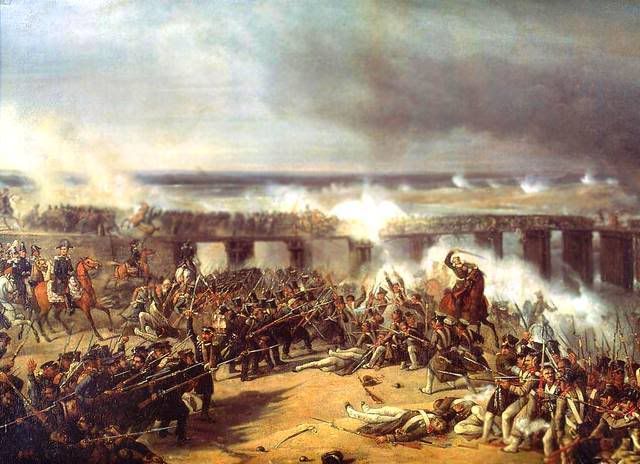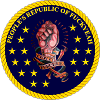Brief history of the Constitutional Republic of PeZookia, Part III
Battle Of Orena
Catherine The Wise led her massive force straight towards the capital city of PeZookia, knowing that King Stanislaw's only chance was to fortify the city. His army could now outmaneuver the Shadow Empire's forces, lacking cavalry, and could not hope to defeat it in a pitched battle in the field.
However, the Shadow advance was slowed down by the need to constantly deal with skirmishers and sharpshooters, poor maps and roads. By the time Catherine reached the vicinity of Orena, the King has finished his preparations for defence of the city and was ready to confront the Shadows.
Alerted by her scouts, Catherine decided to circle the city, fording the Great River north and south from Orena, and then assaulting it from the rear, where fortifications were not as heavy.
However, the local population was strongly on the side of the King, and so Stanislaw III knew every move of the Shadow army. He sallied his cavalry forth from the city, with orders to harass and delay the northern part of the Shadow army, commanded by Catherine herself. Mustering his infantry, the King marched south and intercepted the invaders near the village of Wawer, achieving surprise.
Despite the lower quality of his troops, Stanislaw commanded them agressively, concentrating the infantry attack against center of the Shadow lines. Byzantium-provided muskets of the PeZookians performed admirably, their greater range allowing PeZookian to fire 1.5 volleys for every one of the Shadows.
The Battle Of Wawer lasted for eight hours, culminating in a bayonett charge into musket fire. The highlander regiments broke the backs of Shadow's units, scattering them.
In the north, Catherine has managed to cross the Great River, constantly skirmishing with PeZookian cavalrymen. Knowing nothing about the demise of her southern forces, Catherine deployed her army at the plains west of the city in preparation for her assault. Not knowing that Stanislaw's forces have abandoned it, she commenced operations the next day.
The skeleton crews and militias defending the fortifications on the outskirts of Orena put up a vigorous defence, but were rapidly overwhelmed. As the attackers approached their main target - the Royal Palace - they were surprised by King Stanislaw's forces, who marched overnight to reach the battle in time.
His forces were tired and bloodied from the battle at Wawer, but achieved complete surprise. Bottled inside tight streets of Orena, cut off from her supply lines, Catherine attempted a withdrawal across the river, pressed by advancing PeZookian troops.
The Battle Of Orena concluded eight days later, with the Shadow army routed and in full retreat. Never again would they attempt to annex PeZookia.
Early industrialization
King Stanislaw, having restored power to the Royal Court and beaten back most external threats, he utilized the brief respite for a huge slew of reforms that were supposed to bring the Kingdom into the modern era.
Reforms of financial systems have introduced a decimal monetary system, unifying the varied currency exchange rates and simplifying the use of money in everyday life. This increased efficiency of tax collection and eased trade, and the solution was soon copied by other countries - most notably, Shroomania and Byzantium.
Stanislaw has imported many foreign technical experts and scientists to the country, and charged them with overseeing a campaign of public works. Many of those experts were Byzantine scholars who established schools and universities throughout the country, and aided the development of real science. Despite the shaky relationship with Byzantium (many PeZookians have not forgotten their betrayal not long ago), this aid would prove invaluable later.
To aid the nobles who now lost most of their sources of income to the land reform, laws were introduced regulating private ownership of property and establishment of businesses. Noblemen slowly turned into enterpreneurs, establishing manufacturing workshops and resource-extraction businesses.
These wise economic decisions earned Stanislaw the title Stanislaw The Great, and thus encased him in the annals of PeZookian history forever.
Soon thereafter, PeZookia was on the path to extensive modernization. The forced social reforms were still cause of unrest, with massive migratons occuring between the countryside and cities. Peasants, finally liberated from the ties to the land, moved into cities en masse, attempting to find a better life for themselves. Most ended up in poverty, creating a huge social problem.
Compared to the threat of only a few years past, however, these were minor troubles. The growth of industry and several social programs established by King Stanislaw would pay off in later years, creating a robust, healthy and well-off base of tradesmen, who would become priceless during the later Industrial Revolution.
Colonial ambitions
The country of Rukbat, located on the opposite shore of the Inner Southern Sea, had long since been considered a rich source of natural resources, and thus many continental powers have attempted to seize it. PeZookia was no different - after the country stabilized, king Stanislaw sent several expeditions which landed on Rukbat and established trade factories, mines and logging enterprises. This quickly led to conflict with the native population, who were often victimized by ruthless policies of PeZookian companies. In the period between 1745-1752, a large-scale colonial war erupted in Rukbat, ending with a shaky peace between PeZookia and Rukbatian warlords, which confined PeZookian companies to their ports and trading posts, leaving the resource-rich areas for the natives to utilize.
The Gaymean War
By the end of the XVIIIth century, PeZookia was again a country worthy of her place under the sun. While it missed out on the massive colonial gains of Shroomania and did not posess a geogrpahy as favorable for trade as Byzantium, it rapidly caught up to both countries with industrialization and infrastructural investment. PeZookian goods were widely exported throughout the Old Continent, and population grew rapidly.
This naturally led to further tensions between all continental powers ; Ethnically PeZookian lands under Shroomanian control began stirring as their inhabitants demanded to return to the Motherland, beginning a massive campaign of terror against Shroomanian citizens. Repression and Shroomanization followed, with PeZookian language barred from schools and public administration, forced teaching of Shroomanian language and history, and a massive propaganda campaign.
 The region of Gaymea/Mazhury
The region of Gaymea/Mazhury
The region which was under dispute the most was the region of Mazhury, known to Shroomanians as Gaymea. Nearly 90% PeZookian by now, it was one of the original lands seized by the Knights Of The Pink Cross, later incorporated into the Motherland after the Order had to swear vassalage to the PeZookian Kings.Seized again by Shroomania during the Fall, Gaymea was considered by both sides to be their territorry by right. War was inevitable.
It began when the PeZookian navy engaged a Shroomanian fleet ferrying additional occupation troops to Gaymea ; This move was undertaken despite warnings of PeZookian government, who was growing more and more alarmed with attempts at forced naturalization of Gaymean PeZookians.
The battle was unresolved, but the convoy was forced to withdraw. At the same time, PeZookian ground forces marched into Gaymea, and the Royal Court declared the province liberated, and that it shall remain a part of the Motherland forever.
Shroomania responded, of course, protecting its prestige and land. A massive naval force, led by Admiral Horatio Shroomson, a famed Shroomanian naval hero, sailed towards Gaymea and engaged the PeZookian blockade in the Battle of Oliwa. After a battle lasting for two days, PeZookian navy was in full retreat, having lost four frigates and a ship of the line. Mushroom Marines, wearing coats dyed in Mushroom Gray, landed behind advancing PeZookian forces and marches to meet them.
Both armies clashed near the city of Ostroleka, tall and proud Shroomcoats squaring off against grim-faced PeZookians. The Shroomcoats took full advantage of difficult and broken terrain, however they lacked cavalry support and were outnumbered artillery wise. As the battle raged on, thick smoke filled the field, with Shroomcoats pouring volley after volley into advancing PeZookian collumns.
 Battle of Ostroleka, Orena Museum Of Art
Battle of Ostroleka, Orena Museum Of Art
The fiercest fighting took place on the outskirts of Ostroleka itself, however, where farms surrounded by sturdy low walls were used as cover from musket fire by the Shroomcoats. Shooting irregularly from behind cover, and expertly maneuvering, the Mushroom Marines managed to stave off the assault of the numerically superior PeZookian army.
However, PeZookians were relentless and agressive, knowing full well that Shroomania could not easily or quickly replenish their forces, and any casualties they took that day would be multiplied due to this simple fact. Artillery pounded the farms to dust, and massive human wave assaults pushed the Shroomcoats from building after building.
It was due to this relentless advance, paid for in blood, that PeZookians have finally managed to secure a dominant position over the town. Horses soon drew artillery to the ruined farms, and the mighty guns started shelling the Shroomanians, now caught on lower and unfavorable ground. Wisely, count Welsh MacMillan, commander of the Shroomanian force, withdrew, conceding Ostroleka to the PeZookians, but preserving much of his force to fight another day.
This worsened the situation in Gaymea, but the province was by no means lost. Ostroleka was a major road hub, thus allowing PeZookians increased strategic freedom, but every day they spent marching benefitted the Shroomanians, who prepared fortifications and used their naval superiority to ferry more and more soldiers into the province. On the other hand, PeZookians enjoyed shorter supply lines, and pushed to utilize that advantage to the fullest.
The battle which would resolve the Gaymean War was yet to be fought.
[TO BE CONTINUED]
-----------------------------------
I will write more once I have the inclination ; Now it's sleepy-time.
Besides, I'm drawing close to modern times, which means we have to wait untill everybody else is done


 "
"



